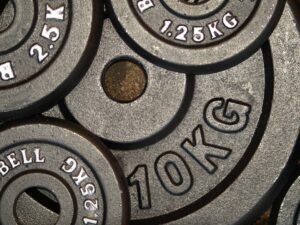Gaining weight and building muscle is a common goal for many people, but doing it in a healthy way can be a challenge. Many people turn to high-calorie, high-fat diets and excessive exercise routines to achieve their weight gain and muscle-building goals, but those methods can have negative impacts on overall health. It is important to bulk up in a healthy way to provide the body with the nutrients it needs to build muscle and gain weight gradually. In this blog post, we will provide you with practical tips and strategies to bulk up healthily, including the right combination of exercise, diet, and supplements, to help you achieve your goal without compromising your health.
1. Why it’s important to gain muscle and weight in a healthy way

Image: pexels
Gaining muscle and weight can be a great way to improve your overall health and fitness. However, it’s important to do it in a healthy way to avoid negative consequences.
Firstly, gaining muscle can help improve your metabolism and burn calories more efficiently. It can also help improve your bone density, which is important in preventing osteoporosis.
However, gaining weight through unhealthy means such as consuming high amounts of processed and fatty foods can lead to health problems such as high blood pressure, high cholesterol, and heart disease. It can also lead to an increased risk of diabetes and other chronic conditions.
In addition, gaining weight through unhealthy means can lead to a decrease in muscle mass, which can negatively impact your overall fitness and health.
Therefore, it’s important to focus on gaining muscle and weight through a healthy diet and exercise plan. This can include consuming nutrient-dense foods such as lean proteins, whole grains, and fruits and vegetables, as well as engaging in regular strength training exercises.
By prioritizing a healthy approach to gaining muscle and weight, you can improve your overall health and fitness while avoiding negative consequences associated with unhealthy weight gain.
2. Understanding your body type and metabolism
Before embarking on a journey to gain muscle and weight, it’s important to understand your body type and metabolism. This knowledge will help you tailor your diet and workout routine to your specific needs and goals.
There are three main body types: ectomorph, mesomorph, and endomorph. Ectomorphs are naturally lean and find it difficult to gain weight and muscle. Mesomorphs have a naturally athletic build and are able to gain muscle and lose fat easily. Endomorphs tend to have a naturally larger build and may find it easier to gain weight, but may struggle with losing fat.
Metabolism also plays a crucial role in weight gain and muscle building. Metabolism refers to the rate at which your body burns calories. Those with a fast metabolism may find it difficult to gain weight, while those with a slower metabolism may find it easier to gain weight but may struggle with losing fat.
Understanding your body type and metabolism will help you determine the right macronutrient ratio and caloric intake needed to achieve your goals. For example, ectomorphs may need to consume more calories and protein to gain muscle and weight, while endomorphs may need to focus on a lower calorie and higher protein diet to lose fat while building muscle.
It’s important to remember that everyone’s body is unique and there is no one-size-fits-all approach to gaining muscle and weight in a healthy way. By understanding your own body type and metabolism, you can create a customized plan that works for you and helps you achieve your goals while maintaining optimal health.
3. Creating a caloric surplus without overeating
Creating a caloric surplus is a must when it comes to gaining muscle and weight. However, this doesn’t give you an excuse to overeat or consume unhealthy foods. You need to make sure that you are consuming a balanced diet that is rich in nutrients and will support muscle growth while keeping you healthy.
To create a caloric surplus, you simply need to consume more calories than you burn. This means that you need to calculate your maintenance calories, which is the number of calories you need to maintain your current weight, and then add an additional 250-500 calories on top of that number. This will ensure that you are consuming enough calories to support muscle growth without overeating.
It’s important to note that not all calories are created equal. You want to focus on consuming nutrient-dense foods that are rich in protein, healthy fats, and complex carbohydrates. This includes foods such as lean meats, fish, nuts, seeds, whole grains, fruits, and vegetables.
Another important factor to consider is meal frequency. Consuming three large meals a day may not be enough to create a caloric surplus. Instead, aim for 4-6 smaller meals throughout the day to ensure that you are consuming enough calories to support muscle growth without overeating.
To track your calorie intake, you can use a food tracking app or website to monitor your daily intake and ensure that you are staying within your caloric goals. With the right balance of healthy foods and a caloric surplus, you can bulk up without compromising your health.
4. Choosing the right macronutrients and meal timing for muscle gain

Image: pixabay
When it comes to gaining muscle, choosing the right macronutrients and timing your meals is crucial. Macronutrients refer to the three major components of our diets – carbohydrates, proteins, and fats. All three macronutrients are important but, when it comes to muscle gain, protein is often considered the most important.
Protein provides the building blocks for muscle growth and repair, so it’s important to consume adequate amounts throughout the day. Aim for a protein-rich meal or snack every three to four hours to keep your muscles fueled and to help prevent muscle breakdown.
In addition to protein, carbohydrates are also important for muscle gain. Carbohydrates provide the energy your body needs to fuel intense workouts and help replenish glycogen stores after exercise. Aim for complex carbohydrates, such as whole grains, fruits, and vegetables, to provide sustained energy and important nutrients.
While fats may not necessarily contribute to muscle gain, they are important for overall health and shouldn’t be neglected. Aim for healthy sources of fats, such as nuts, seeds, avocado, and olive oil.
In terms of meal timing, aim to consume a protein-rich meal or snack within 30 minutes of completing your workout. This will help kick-start the muscle repair and growth process. Additionally, try to spread your protein intake evenly throughout the day to keep your muscles fueled and to prevent muscle breakdown.
By choosing the right macronutrients and timing your meals appropriately, you can fuel your muscles for optimal growth and achieve your muscle gain goals without compromising your health.
5. The importance of hydration and electrolytes
When it comes to gaining muscle and weight, many people focus solely on their diet and exercise routine. However, staying properly hydrated and maintaining electrolyte balance is just as important.
During exercise, our bodies lose water and electrolytes through sweat, which can lead to dehydration and muscle cramping. This can negatively impact our workouts and slow down our progress.
To avoid dehydration, it’s important to drink plenty of water throughout the day, especially before, during, and after exercise. Aim for at least 8-10 glasses of water per day, and more if you are sweating excessively.
In addition to water, electrolytes such as sodium, potassium, and magnesium are also lost during exercise. Incorporating electrolyte-rich foods such as bananas, sweet potatoes, and leafy greens into your diet can help replenish these important minerals.
Another option is to drink an electrolyte sports drink during or after exercise to help replenish lost electrolytes. Just be sure to choose a brand that is low in added sugar and artificial ingredients.
Remember, proper hydration and electrolyte balance are key to maintaining optimal performance and achieving your muscle gain and weight goals.
6. Incorporating strength training into your workout routine
If you’re looking to bulk up and gain muscle mass, it’s essential to incorporate strength training into your workout routine. Strength training is a type of exercise that involves using resistance to build muscle strength, endurance, and size. Weightlifting, resistance band training, and bodyweight exercises are all effective forms of strength training that can help you achieve your muscle-building goals.
When it comes to strength training, it’s important to focus on compound exercises that work multiple muscle groups at the same time. Exercises like squats, deadlifts, bench press, and pull-ups are great examples of compound exercises that can help you build muscle mass and strength quickly.
It’s also important to gradually increase the amount of weight you lift over time. This progressive overload is essential for stimulating muscle growth and preventing a plateau in your progress. Start with a weight that is challenging but doable for you, and gradually increase the weight as your strength improves.
In addition to strength training, it’s important to fuel your body with the right nutrients to support muscle growth. Aim to consume a balanced diet rich in protein, complex carbohydrates, and healthy fats. Protein is especially important for muscle building, so make sure you’re consuming enough of it to support your muscle-building goals.
Overall, incorporating strength training into your workout routine is an essential part of gaining muscle mass and weight in a healthy way. With the right training plan and nutrition, you can achieve your muscle-building goals while still prioritizing your health and well-being.
7. How to progress in weightlifting for optimal muscle growth
When it comes to weightlifting, there are a few key principles that you should follow to ensure optimal muscle growth. First and foremost, progressive overload is essential. This means gradually increasing the amount of weight that you lift over time. Your muscles adapt to the stress of lifting weights, so you need to continually challenge them in order to see results.
In addition, you should focus on compound exercises that work multiple muscle groups at once. Squats, deadlifts, bench press, and pull-ups are all great examples of compound exercises that can help you build muscle quickly and efficiently.
It’s also important to vary your workouts and switch up your exercises every few weeks. This helps prevent your muscles from adapting to the same routine and plateauing in growth.
Rest and recovery are also crucial for muscle growth. Your muscles need time to repair and rebuild after a workout, so make sure you’re getting enough sleep and giving yourself adequate rest days.
Finally, be patient and consistent. Building muscle takes time and dedication, but if you stick with it and follow these principles, you’ll see results.
8. Avoiding injury and promoting recovery

Image: pixabay
Gaining muscle and weight is not an easy task, but it can become even harder if you get injured along the way. Injuries can slow down or even halt the progress you’ve made, and sometimes, they can even push you backwards. Therefore, it’s important to take measures to avoid injury and promote recovery.
Firstly, never lift weights beyond your capacity. Start with lighter weights and gradually increase them as your strength and endurance improve. This will help you build a strong foundation and reduce the risk of injuries.
Secondly, always warm up before exercising. Warm-ups increase blood flow to your muscles and prepare them for the workout ahead. Stretching is also important to loosen up your muscles and improve your flexibility.
Thirdly, make sure you’re using proper form and technique when lifting weights. Improper form can put unnecessary strain on your muscles and joints, which can lead to injury. If you’re unsure about your form, seek advice from a personal trainer.
Fourthly, rest and recovery are equally important as exercise. Make sure to give your muscles enough time to recover between workouts. This can be done by taking rest days or doing low-intensity workouts on those days. Additionally, getting enough sleep is crucial for recovery as it allows your body to repair and rebuild muscle tissue.
Finally, listen to your body. If you feel pain, discomfort or fatigue, it’s important to take a break and let your body rest. Pushing through pain can exacerbate injuries and set you back even further. By taking these measures, you can minimize the risk of injury and promote recovery, which will help you achieve your muscle and weight gain goals in a healthy way.
9. Balancing rest and activity for optimal muscle gain
When it comes to gaining muscle and weight, it’s not just about working out hard in the gym or eating a lot of calories. Rest and recovery play a critical role in maximizing your muscle gains.
When you work out, you create small tears in your muscles, and it’s during rest and recovery that your muscles repair and grow back stronger. Therefore, it’s important to give your muscles time to recover between workouts.
It’s recommended to have at least 48 hours of rest between workouts targeting the same muscle group. This allows your muscles to repair and grow back stronger, which is essential for long-term muscle growth.
In addition to rest, it’s important to stay active throughout the day. Sitting for extended periods can slow down your metabolism and reduce muscle growth. Simple activities like taking regular walks, doing some light stretching, or standing up and moving around every hour can help increase blood flow and promote muscle recovery.
Also, make sure to get enough sleep. Sleep is a critical time for muscle recovery and growth. Aim for 7-9 hours of quality sleep each night to maximize your gains.
In short, balancing rest and activity is essential for building muscle mass while maintaining good health. Don’t push yourself too hard and remember to give your body the recovery time it needs.
10. Keeping track of progress and adjusting your plan accordingly
Keeping track of progress is crucial when it comes to gaining muscle and weight. It allows you to see how far you’ve come and make adjustments to your plan if necessary. There are different ways to track your progress, and the method you choose depends on your preferences and what works best for you.
One way to track progress is by taking measurements of your body, such as your weight, body fat percentage, and muscle mass. You can do this on a weekly or monthly basis, depending on how often you want to see changes. Another way to track progress is by taking progress photos. This involves taking photos of yourself at regular intervals and comparing them to see how your body has changed over time.
It’s also important to keep track of your workouts. This includes the exercises you do, the weight you lift, and the number of reps and sets you perform. By keeping a workout log, you can see how you’re progressing and make adjustments to your routine accordingly. For example, if you’re not seeing any gains in a particular exercise, you may need to increase the weight or change the exercise altogether.
Finally, it’s important to adjust your plan as you go along. Your body will adapt to your routine over time, so you need to keep challenging it to see results. This may involve increasing the weight you lift, changing the exercises you do, or adding new exercises to your routine. By keeping track of your progress and adjusting your plan accordingly, you can ensure that you continue to make gains and achieve your fitness goals.







Leave a Reply